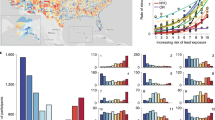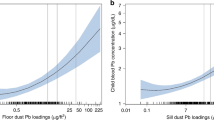Abstract
Thirteen infants born into the lead contaminated environment of Port Pirie, South Australia, were followed approximately monthly from birth until they were about 36 months. Blood-lead levels of infants at birth were similar to their mothers but fell rapidly during the first 35 days of life. Thereafter, infants born with blood-lead levels at about 2–4 μg/dl began a slow linear increase until 14–18 months where a plateau occurred of 10.8–17.2 μg/dl. The blood-lead levels were well correlated with hand-lead loadings of infant (r2=0.72, P<0.01, log transformed data) and mother (r2=0.62, P<0.01, log transformed data) unless the birth lead level was exceptionally high. The principle factor determining exposure was thee impact of smelter emissions on the house. Blood-lead increase was caused by the relatively more rapid increase in dose of lead compared with the increasing body mass, which was related directly to the maturation of motor development. Hand-lead of mothers were closely related to both infants' blood- and hand-lead levels until the point of blood-lead plateau then substantially fell as infants began to walk unaided. The estimated slope factor using the ICRP model was 0.75–0.94 μg/dl per μg/day with a maximum daily dose of 3–5 μg/kg/day, assuming 45% absorption. Ingestion appears to be the most likely route for at least 95% of the dose.
This is a preview of subscription content, access via your institution
Access options
Subscribe to this journal
Receive 6 print issues and online access
$259.00 per year
only $43.17 per issue
Buy this article
- Purchase on Springer Link
- Instant access to full article PDF
Prices may be subject to local taxes which are calculated during checkout




Similar content being viewed by others
References
Australian Standard 2411-1993. Venous Blood — Determination of Lead Content — Flame Atomic Absorption Spectrometric Method. Standards Association of Australia, Sydney, 1993.
Australian Standard 2636-1983. Sampling of Venous and Capillary Blood for the Determination of Lead Content. Standards Association of Australia, Sydney, 1983.
Australian Standard 4090-1993. Whole Blood — Determination of Lead Content — Graphite Furnace Atomic Absorption Spectrometric Method. Standards Association of Australia, Sydney, 1993.
Avery G.B., Fletcher M.A., and MacDonald M.G. Neonatology, Pathophysiology and Management of the Newborn, 4th edn. Lippincott, Philadelphia, 1994.
Baghurst P.A., McMichael A.J., Vimpani G., Robertson E.F., Clark P.D., and Wigg N.R. Determinants of blood lead concentrations of pregnant women living in Port Pirie and surrounding areas. Med J Aust 1998: 146: 69–73.
Black K., Shalat S.L., Freeman N.C.G., Jimenez M., Donnelly K.C., and Calvin J.A. Children's mouthing and food-handling behavior in an agricultural community on the US/Mexico border. J Exp Anal Environ Epidemiol 2005: 15: 244–251.
Body P.E., Inglis G.R., and Mulcahy D.E. Lead Contamination in Port Pirie, South Australia: A Review of Environmental Lead Which Could Give Rise to an Increase in Children's Blood Lead Levels. Department of Environment and Planning, South Australia, Adelaide, 1988.
Bornschein R.L., Succop P., Dietrich K.N., Clark C.S., Que Hee S., and Hammond P.B. The influence of social and environmental factors on dust lead, hand lead and blood lead levels in young children. Environ Res 1985: 38: 108–118.
Bornschein R.L., Succop P., Kraft K.M., Clark C.S., Peace B., and Hammond P.B. Exterior surface dust lead, interior house dust lead and childhood lead exposure in an urban environment. Hemphill, D. D. Trace Subst Environl Health 1986: 2: 322–332.
Brinkman S., Gialamas A., Jones L., Edwards P., and Maynard E.J. Child Activity Patterns for Environmental Exposure Assessment in the Home. National Environmental Health Forum, Adelaide, 1999.
Calder I.C., Maynard E.J., and Heyworth J.S. Port Pirie lead abatement program, 1992. Environ Geochem Health 1994: 16: 137–145.
Cohen Hubal E.A., Sheldon L.S., Burke J.M., McCurdy T.R., Berry M.R., Rigas M.L., Zartarian V.G., and Freeman N.C.G. Children's exposure assessment: a review of factors influencing children's exposure, and the data available to characterize and assess that exposure. Environ Health Perspect 2000: 108: 475–486.
Cowan R.J., and Conley M.M. Surface area of the hand and digits. Can J Surg 1973: 16: 187–194.
Davies D.J.A., Thornton I., Watt J.M., Culbard E.B., Harvey P.G., Delves H.T., Scherlock J.C., Smart G.A., Thomas J.F.A., and Quinn M.J. Lead intake and blood lead in two-year-old UK urban children. Sci Total Environ 1990: 90: 13–29.
Ferro A.R., Kopperud R.J., and Hildemann L.M. Elevated personal exposure to particulate matter from human activities in a residence. J Exp Anal Environ Epidemiol 2004: 14: S34–S40.
Gulson B.L., Gray B., Mahaffey K.R., Jameson C.W., Mizon K.J., Patison N., and Korsch M. Comparison of the rates of exchange of lead in the blood of newly born infants and their mothers with lead from their current environment. J Lab Clin Med 1999: 133: 171–178.
Gulson B.L., Mizon K.J., Davis J.D., Palmer J.M., and Vimpani G. Identification of sources of lead in children in a primary zinc-lead smelter environment. Environ Health Perspect 2004: 112: 52–60.
Hilts S.R., Hertzman C., and Marion S.A. A controlled trial of the effect of HEPA vacuuming on childhood lead exposure. Can J Public Health 1995: 86: 345–350.
Hsu D.J., and Swift D.J. The measurements of human inhalability of ultralarge aerosols in calm air using manikins. J Aerosol Sci 1999: 30: 1331–1343.
Kemp C.A., McDowell J.M., Lilley B.J., Munari G.A., O'Sullivan C.E., South S., and Tibballs J. Paediatric Pharmacopoeia, 12th ed. Pharmacy Dept., Royal Children's Hospital, Melbourne, 1997.
Kranz B., Simon D.L., and Leonardi B. The behavior and routes of lead exposure in pregrasping infants. J Exp Anal Environ Epidemiol 2004: 14: 300–311.
Kutlaca A. Mechanisms of Entry of Lead-Bearing Dusts into Houses in Port Pirie. Ph.D. Thesis The Mawson Graduate Centre for Environmental Studies, University of Adelaide, 1998.
Lanphear B.P., and Roghmann K. Pathways of lead exposure in urban children. Environ Res 1997: 74: 67–73.
Lanphear B.P., Hornung R., Khoury J., Yolton K., Baghurst P., Bellinger D.C., Canfield R.L., Dietrich K.N., Bornschein R.L., Greene T., Rothenberg S.J., Needleman H.L., Schnaas L., Wasserman G., Graziano J., and Roberts R. Low-level environmental lead exposure and children's intellectual function: an international pooled analysis. Environ Health Perspect 2005: 113: 894–899.
Lanphear B.P., Matte T.D., Rogers J., Clickner R.P., Dietz B., Bornschein R.L., Succop P., Mahaffey K.R., Dixon S., Galke W., Rabinowitz M.B., Farfel M., Rohde C.A., Schwartz J., Ashley P., and Jacobs D.E. The contribution of lead-contamination house dust and residential soil to children's blood lead levels. Environ Res 1998: 79: 51–68.
Leggett R.W. An age-specific kinetic model of lead metabolism in humans. Environ Health Perspect 1993: 101: 598–616.
Manton W.I., Angle C.R., Stanek K.L., Reese Y.R., and Keuhnemann T.J. Acquisition and retention of lead by young children. Environ Res 2000: 82: 60–80.
Mathews J.N.S., Altman D.G., Campbell M.J., and Royston P. Analysis of serial measurements in medical research. BMJ 1990: 300: 230–235.
Maynard E.J., Franks L.J., and Malcolm M.S. The Port Pirie Lead Implementation Program. Future Focus and Directions. Department of Health, Adelaide, South Australia, 2006.
Maynard E.J., Thomas R., Simon D., Phipps C., Ward C., and Calder I. An evaluation of recent blood lead levels in Port Pirie, South Australia. Sci Total Environ 2003: 303: 25–33.
McMichael A.J., Baghurst P.A., Robertson E.F., Vimpani G., and Wigg N.R. The Port Pirie cohort study. Blood lead concentrations in early childhood. Med J Aus 1985: 143: 499–503.
MMWR. Blood Lead Levels — United States, 1999–2002. MMWR 2005: 54: 513–516: 1997.
Nagel T.R., and Schunk J.E. Using the hand to estimate the surface area of a burn in children. Pediatr Emerg Care 1997: 13: 254–255.
O'Flaherty E.J. Physiologically based models for bone-seeking elements. V. Lead absorption and disposition in childhood. Toxicol Appl Pharmacol 1995: 131: 297–308.
Ong C.N., and Lee W.R. High affinity of lead for fetal haemoglobin. Br J Ind Med 1980: 37: 292–298.
Rabinowitz M.B., Leviton A., Needleman H., Bellinger D., and Waternaux C. Environmental correlates of infant blood lead levels. Environ Res 1985: 38: 96–107.
Roels H.A., Buchett J., Lauwerys R.R., Bruaux P., Claeys-Thoreau F., LaFontaine A., and Verduyn G. Exposure to lead by the oral and the pulmonary routes of children living in the vicinity of a primary lead smelter. Environ Res 1980: 22: 81–94.
Succop P., Bornschein R.L., Brown K., and Tsung C.Y. An empirical comparison of lead exposure pathway models. Environ Health Perspect 1998: 106(Suppl 6): 1577–1583.
Tiller K.G., Merry R.H., Cartwright B., and Bartlett N.R. Dispersal of lead emissions from an isolated lead smelter within an agricultural region of South Australia. Search 1975: 6: 437–439.
Tulve N.S., Suggs J.C., McCurdy T., Cohen Hubal E.A., and Moya J. Frequency of mouthing behavior in young children. J Exp Anal Environ Epidemiol 2002: 12: 259–264.
US EPA 1994. Technical Support Document for the Integrated Exposure Uptake Biokinetic Model for Lead in Children (v.099d) Technical Review Group for Lead (US EPA) NTIS #PB94-963505, EPA 9285.7–22, 1994.
US EPA Exposure Factors Handbook: Volume 1- General Factors. US EPA, Washington, 1997.
Vimpani G., McMichael A.J., Robertson E.F., and Wigg N.R. The Port Pirie Study: A prospective study of pregnancy outcome and early childhood growth and development in a lead-exposed community — protocol and status report. Environ Res 1985: 38: 19–23.
Acknowledgements
Early work on this study was undertaken by Sally Brinkman (formally with Port Pirie Environmental Health Centre, Public Health, Department of Health: South Australia) and Raylene Thomas (Public Health, Department of Health: South Australia). The blood-lead sampling and interviews were conducted by Raylene Thomas and Charmayne Jebb (Public Health, Department of Health: South Australia). Data entry was conducted by Charmayne Jebb and Kathy Thomas (Public Health, Department of Health: South Australia). Analytical expertise for the testing of hand-lead loadings was provided by Mike van Alphen (formally with Port Pirie Environmental Health Centre, Public Health, Department of Health: South Australia) with Angela Gialamas (formally with Port Pirie Environmental Health Centre, Public Health, Department of Health: South Australia) and Anna Swanepoel (formally with Port Pirie Environmental Health Centre, Public Health, Department of Health: South Australia) preparing them for analysis.
Author information
Authors and Affiliations
Corresponding author
Rights and permissions
About this article
Cite this article
Simon, D., Maynard, E. & Thomas, K. Living in a sea of lead — changes in blood- and hand-lead of infants living near a smelter. J Expo Sci Environ Epidemiol 17, 248–259 (2007). https://doi.org/10.1038/sj.jes.7500512
Received:
Accepted:
Published:
Issue Date:
DOI: https://doi.org/10.1038/sj.jes.7500512
Keywords
This article is cited by
-
Locally produced chicken eggs—a source of dietary lead for an Australian community living with an active lead smelter?
Journal of Exposure Science & Environmental Epidemiology (2019)
-
Comments on manuscript—Zheng, J., Huynh, T., Gasparon, M., Ng, J. and Noller, B., 2013. Human health risk assessment of lead from mining activities at semi-arid locations in the context of total lead exposure. Environmental Science and Pollution Research, 20, 8404–8416
Environmental Science and Pollution Research (2015)
-
Arsenic distribution and bioaccessibility across particle fractions in historically contaminated soils
Environmental Geochemistry and Health (2009)



